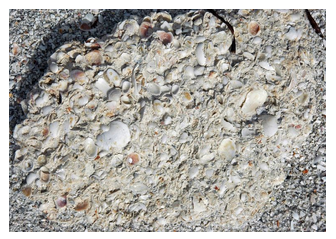7.5.3: Organic Sedimentary Rocks
- Page ID
- 18721

Some sedimentary rocks are formed largely from biogenic (organic) debris. We classify such rocks as organic sedimentary rocks, separate from chemical and clastic sedimentary rocks. Examples are limestones formed from shell or skeletal remains, coquina (a sedimentary rock made of shell fragments), diatomite (a sedimentary rock made of the remains of diatoms), and coal. This photo (Figure 7.77) shows an example of coquina.
Much overlap exists between chemical, clastic, and organic sedimentary rocks. Many chemical sedimentary rocks contain clastic material, and many clastic sedimentary rocks are held together by chemical cements precipitated from water. Both chemical and clastic rocks may contain biogenic components.


